The moonflower is a unique plant known for its night-blooming white flowers and captivating fragrance. It has long been associated with deep spiritual meanings across many cultures. Its spiritual symbolism includes intuition, transformation, purity, love, and connection to the divine. This makes it a powerful symbol for those interested in spiritual growth and inner reflection.
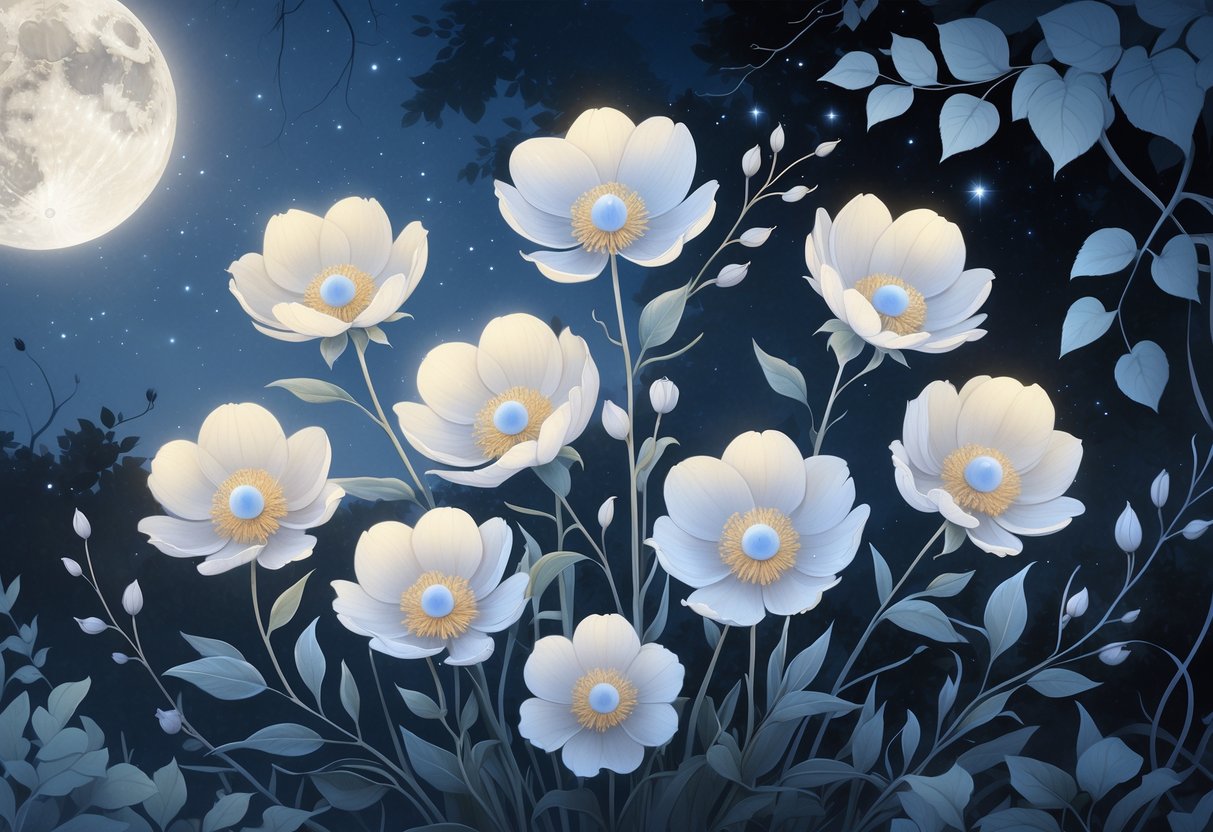
Moonflowers are often linked to feminine energy and the cycles of life, reflecting themes of change and renewal. They have a special place in mythology and folklore, where they represent mystery, beauty, and the unseen world. Many also see the moonflower as a guide for spiritual awakening and protection during dark or uncertain times.
Understanding these meanings helps reveal why the moonflower continues to inspire artists, healers, and spiritual practitioners. Its symbolism goes beyond appearance, touching on healing, love, and the balance between light and darkness in life.
Key Takeways
- The moonflower symbolizes deep spiritual growth and intuition.
- It represents transformation, purity, and feminine energy.
- The flower holds cultural and healing significance worldwide.
Overview of the Moonflower
The moonflower is known for its unique nighttime blooming and striking white blossoms. It has specific growth traits and plays an important role in the environment by attracting certain pollinators. These characteristics link it closely to moonlight and natural cycles.
Botanical Features and Growth Habit
The moonflower is a fast-growing vine native to tropical and subtropical America. Its scientific name is Ipomoea alba, and it belongs to the Convolvulaceae family. The plant has heart-shaped leaves and climbs by twining around supports.
Its large, trumpet-shaped flowers are pure white and measure up to six inches across. Moonflowers can reach heights of 10 to 15 feet when given sufficient support. In warmer climates, it grows as a perennial, but in cooler areas, it may behave like an annual due to frost sensitivity.
The moonflower prefers well-drained, fertile soil and full sun. It needs regular watering but should not stay waterlogged. This plant is often cultivated in gardens for its beauty and fragrance.
Nocturnal Blooming and Moonlight Connection
One of the main features of the moonflower is its nocturnal blooming. The flowers open only in the late evening and close by morning. This behavior is closely tied to its name and the mystical aura of moonlight.
The white color of the moonflower’s petals enhances visibility in low light, creating an ethereal glow under the moon. The scent is also strongest at night, helping it attract moths and other nighttime pollinators.
This nighttime blooming cycle links the moonflower to themes like intuition, mystery, and transformation in many cultures. Its connection to the moon symbolizes clarity and spiritual awakening.
Role in Ecosystems and Attraction of Pollinators
Moonflowers play a specific role in their ecosystems by supporting night-active pollinators. Their white petals and strong fragrance are designed to attract moths, especially hawk moths, which are effective pollinators.
Because the moonflower blooms only at night, it avoids competition with daytime flowers for pollination. This nocturnal strategy helps maintain balance in pollinator networks.
The plant also provides habitat and food for some insects and animals. This ecological function adds to its cultural and spiritual importance tied to cycles of life and renewal.
Core Spiritual Meanings of the Moonflower
The moonflower holds deep spiritual significance connected to its nocturnal blooming and delicate beauty. It symbolizes hidden truths, personal growth, and calmness. These meanings reflect its unique nature and impact on spiritual practices.
Mystery and Symbolism of the Night
The moonflower blooms at night, linking it closely to mystery and the unknown. Its nighttime opening represents the hidden or unconscious parts of the self that emerge when darkness falls. This characteristic makes it a symbol of the subconscious mind and spiritual insight.
The flower’s white glow in the darkness suggests purity within mystery, inviting reflection on what lies beneath surface appearances. Cultures often see this flower as a guide to understanding deeper spiritual truths that are not visible during the day.
Its connection to the moon adds layers of symbolism involving intuition and emotional depth. The moonflower encourages exploration of inner mysteries and acceptance of life’s unseen forces.
Transformation and New Beginnings
The moonflower’s cycle of blooming at night and closing by dawn symbolizes transformation and renewal. It reflects the idea that growth often happens in phases, sometimes hidden from public view.
This plant encourages embracing change and trusting the process of personal evolution. The temporary yet recurring bloom stands for new beginnings that follow endings, symbolizing hope and resilience.
Many spiritual traditions use the moonflower as a reminder that darkness is not an end but a stage before light returns. It inspires people to see challenges as opportunities for growth and rebirth.
Inner Peace and Tranquility
The moonflower’s calming fragrance and gentle presence promote inner peace and relaxation. It is viewed as a natural aid for calming anxious minds and easing stress.
Spiritually, this flower represents tranquility that arises from acceptance and harmony with one’s surroundings. Its night bloom signals a quiet time for rest and reflection.
Meditators and healers may use the moonflower to foster a peaceful mental state, helping connect with deeper calmness. Its energy supports healing both emotionally and spiritually by encouraging stillness and mindfulness.
Feminine Energy and Intuition
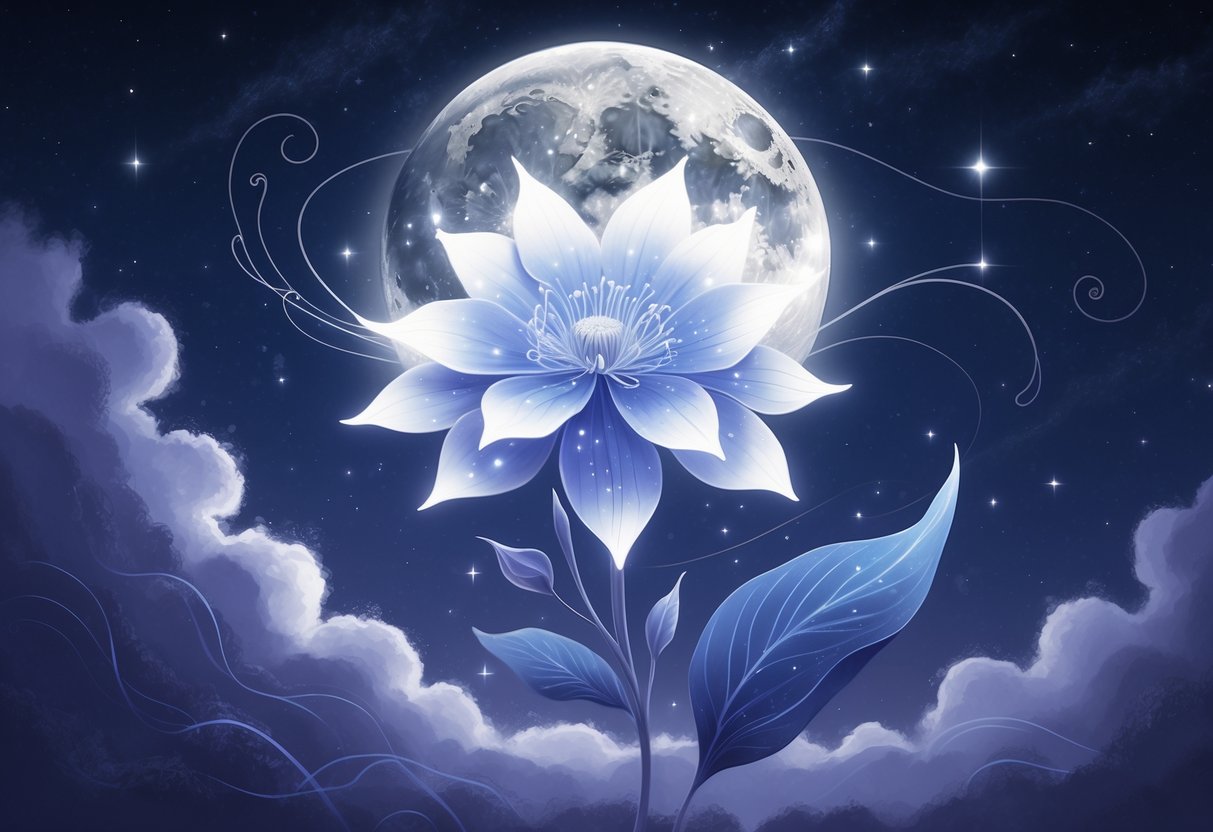
The moonflower is closely linked to themes of feminine energy and intuition. Its growth and blooming cycle reflect natural rhythms tied to the moon, embodying qualities like emotional depth, inner knowing, and spiritual insight. This connection shapes its symbolic meaning in many cultures.
Divine Feminine Association
The moonflower is widely seen as a symbol of the divine feminine. Its soft white petals and night-blooming habit represent purity, grace, and the nurturing side of femininity. People often associate the flower with qualities such as sensitivity, gentleness, and creativity.
This flower’s connection to femininity also reflects the balance between strength and vulnerability. It captures the idea of feminine power that is both quiet and resilient. Moonflowers are sometimes used in rituals or celebrations that honor women or feminine energy in life and nature.
Lunar Influence on Intuition
The moonflower’s close relationship with the moon links it strongly to intuition. The moon governs cycles, emotions, and the subconscious mind, which are all aspects tied to intuitive awareness.
Because the moonflower blooms only at night, it symbolizes the mysteries hidden in the dark. This quality points to the power of intuition to reveal truths that logic alone cannot reach. The flower is often thought to enhance psychic abilities and emotional clarity through its lunar connection.
Connection to Moon Goddesses
Moonflowers have historical ties to moon goddesses in different cultures. In Greek mythology, for example, they are connected to Selene, a moon goddess who personifies moonlight and beauty. The flower reflects her radiant yet gentle presence.
They are also linked to Artemis, the goddess of the hunt and the moon, symbolizing purity and protection. These associations highlight the moonflower’s role as a spiritual symbol connected to feminine divine figures who govern intuition, protection, and mysticism.
Love and Romantic Symbolism
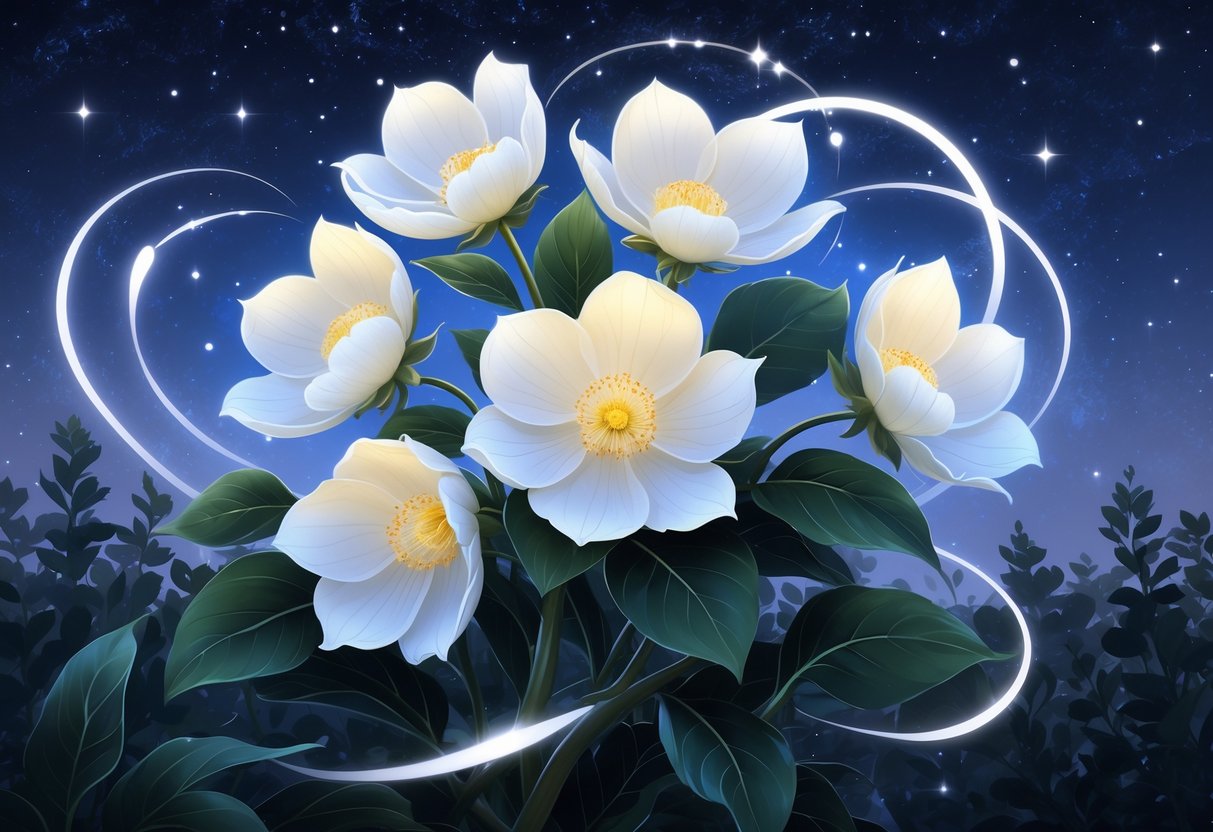
The moonflower has deep connections to love that go beyond simple attraction. Its nighttime bloom and delicate beauty symbolize both hidden feelings and strong, steady commitment. These qualities make the moonflower a meaningful symbol in romantic contexts.
Secret Love and Emotional Depth
The moonflower’s habit of blooming only at night links it to secret, quiet emotions. It represents love that is felt deeply but not always openly shown. This flower symbolizes hidden affection and the mysterious layers of emotional connection between partners.
Because it thrives in darkness, the moonflower suggests that true feelings can grow even when love isn’t obvious or widely expressed. It reflects the subtle power of unspoken devotion and emotional intimacy that builds quietly over time.
Quiet Strength in Relationships
The moonflower also stands for steady, enduring love. It shows how relationships can grow strong and resilient, even when they face challenges or remain private. Its ability to bloom beautifully in the dark is a metaphor for couples who support and protect each other through difficult times.
Moonflower symbolism encourages patience and trust. It underlines the idea that love does not always need to be loud or dramatic to be powerful. It honors commitment based on deep respect and silent support, giving strength to lasting bonds.
Healing Properties and Spiritual Guidance
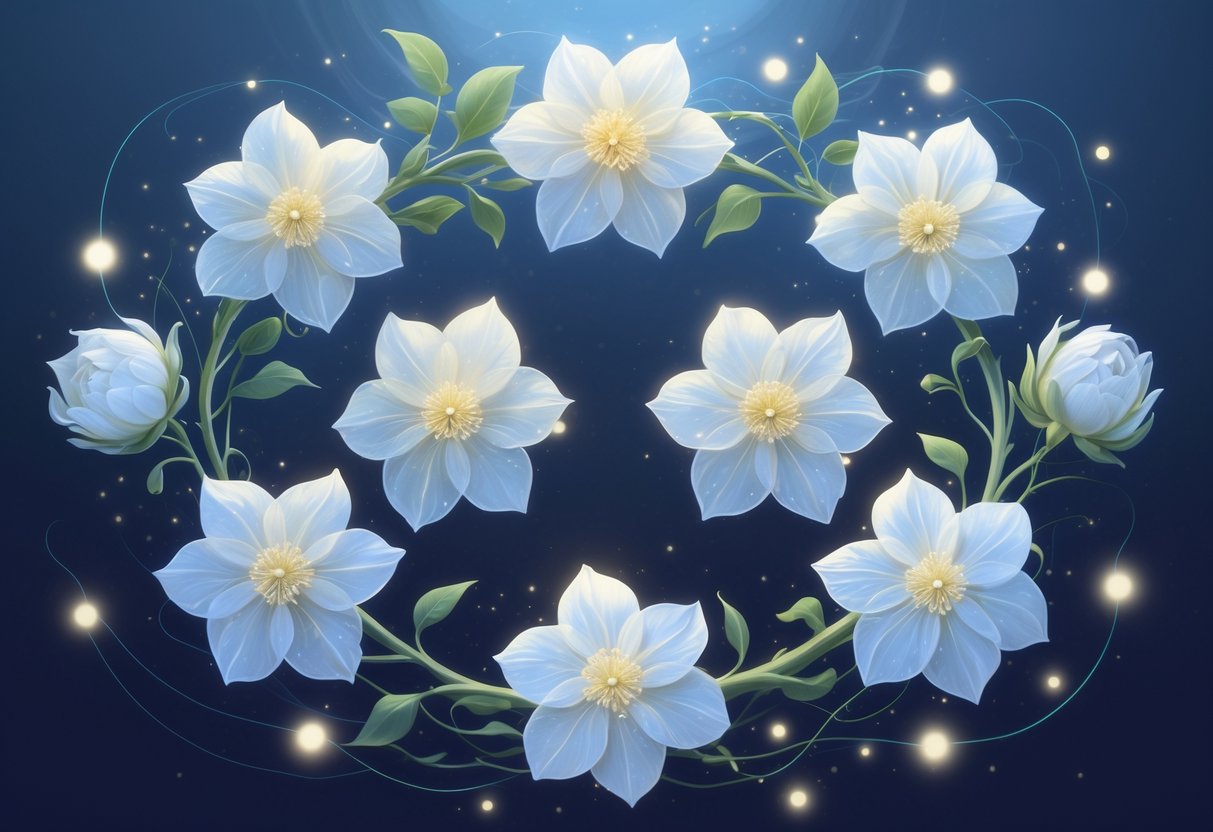
The moonflower is valued not only for its beauty but also for its role in healing and spiritual support. It holds natural anti-inflammatory qualities and serves as a symbol for finding light in difficult times.
Traditional Healing and Anti-Inflammatory Uses
Moonflowers have been used in traditional remedies for their calming effects. Many cultures apply parts of the plant to reduce inflammation and soothe minor skin irritations. Its natural compounds are believed to ease swelling and promote faster recovery from injuries.
In herbal medicine, moonflower extracts are sometimes included in treatments for pain relief and calming anxiety. However, care is taken because certain types can be toxic if misused. The plant’s dual nature as both healing and harmful means it is applied cautiously under guidance.
Guidance Through Darkness
Spiritually, the moonflower symbolizes light in darkness and emotional healing. It is associated with clarity during confusing or difficult periods. Its night-blooming nature represents finding insight when facing challenges or uncertainty.
People often use the moonflower’s imagery in meditation or rituals to help connect with intuition and inner wisdom. It is believed to support spiritual growth by encouraging reflection and calmness even in times of struggle. This flower inspires perseverance and renewed hope.
Moonflower Colors and Their Unique Meanings
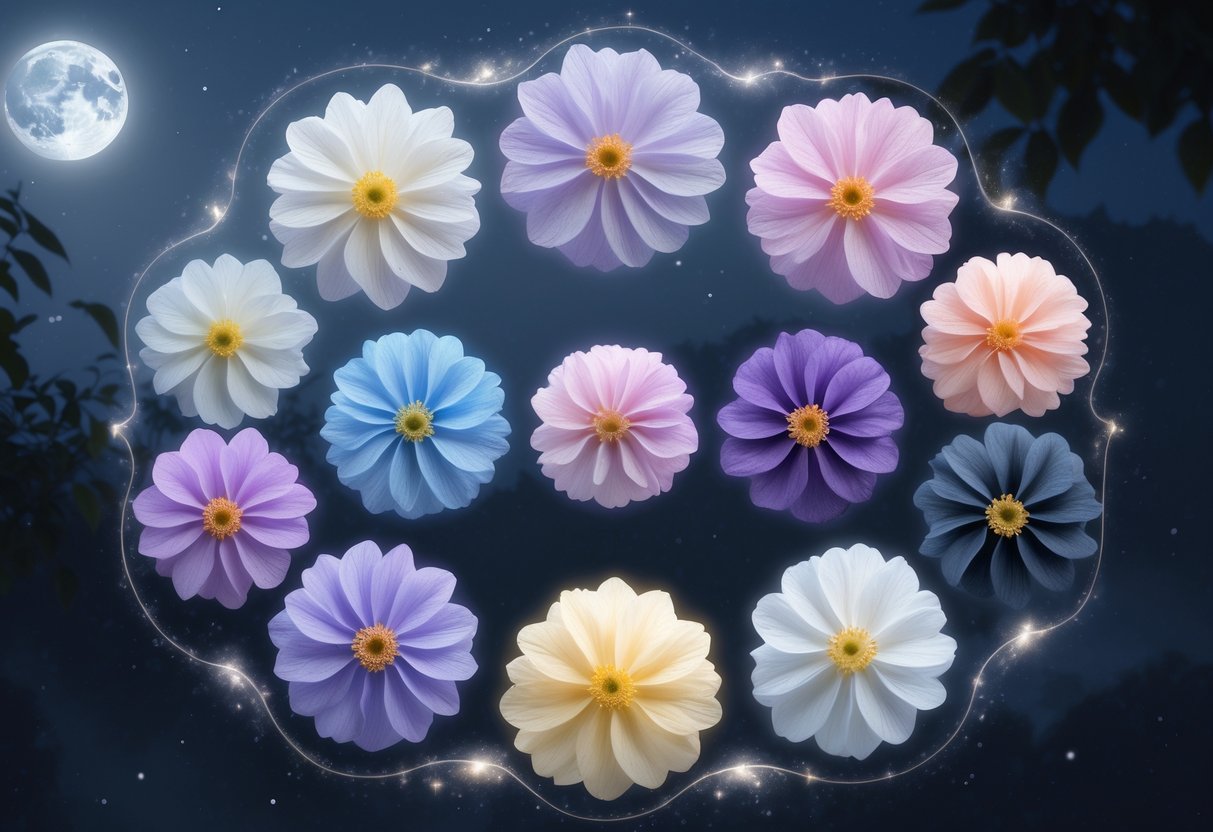
Moonflowers come in different colors, each carrying its own special spiritual meaning. These meanings highlight qualities such as purity, calmness, and care. Understanding these colors helps reveal what the flower symbolizes in different contexts.
White Moonflowers: Purity and Spiritual Light
White moonflowers are the most common and symbolize purity and spiritual light. Their bright, glowing blooms stand out in the darkness, representing hope and clarity during difficult times. The whiteness connects to ideas of innocence and new beginnings.
This color also signifies enlightenment and the awakening of the soul. White moonflowers remind people to stay true to themselves while finding peace in the quiet of night. They often symbolize a clear path toward spiritual growth and emotional healing.
Pink Moonflowers: Compassion and Nurturing
Pink moonflowers represent compassion and nurturing. Their soft hue reflects love that is gentle and caring, making them symbols of kindness and emotional support. Pink moonflowers encourage empathy and connection with others.
They are often seen as a sign to offer comfort during hard times. The pink shade ties strongly to tenderness and the nurturing energy needed to help heal emotional wounds. It invites people to open their hearts and be present for loved ones.
Blue Moonflowers: Deep Calm and Insight
Blue moonflowers carry meanings of deep calm and insight. The color blue is linked to wisdom and peacefulness, making these moonflowers symbols of mental clarity and relaxation.
They help inspire reflection and inner understanding. Blue moonflowers suggest a connection to intuition and thoughtful awareness. Their calm tone encourages mindfulness and a steady focus on personal growth and spiritual balance.
Cultural and Mythological Interpretations
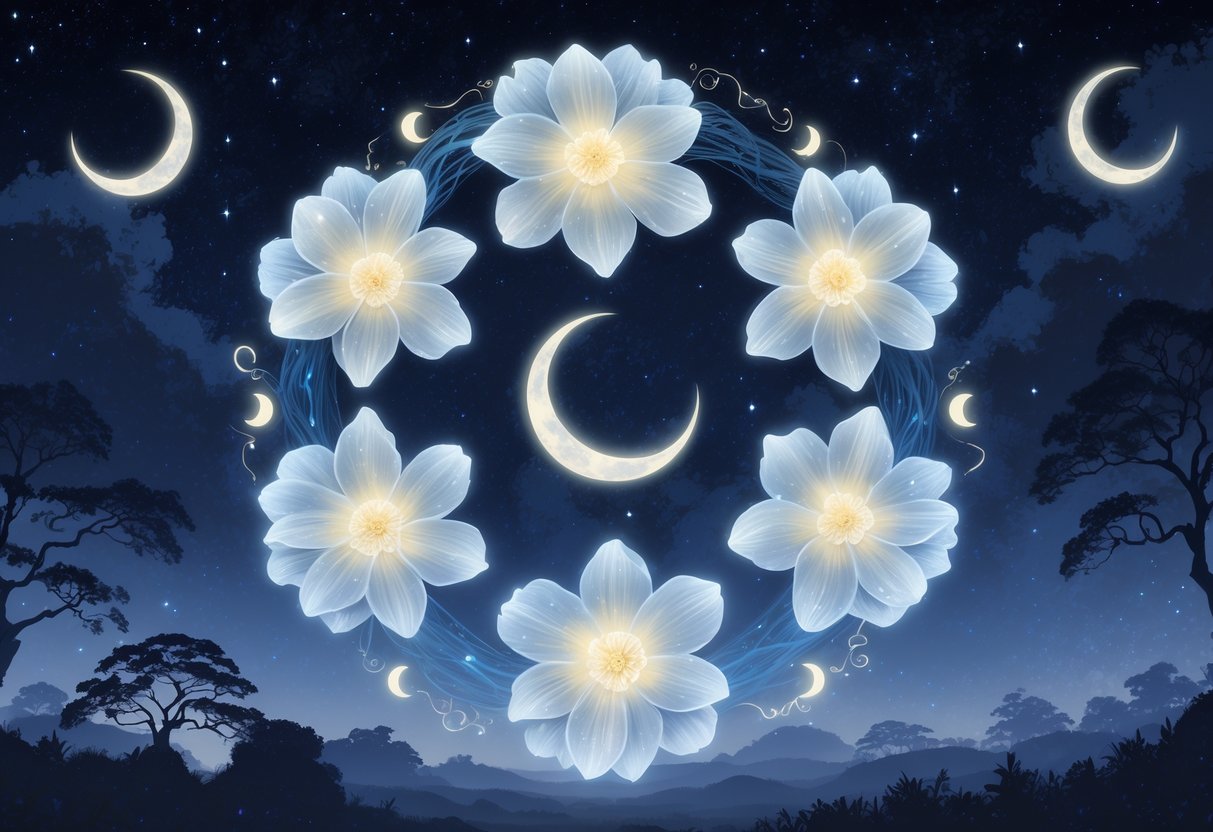
The moonflower holds important meanings in many cultures and myths, especially linked to the moon goddess and spiritual ceremonies. Its role in rituals and artistic traditions highlights its connection to feminine energy, spirituality, and nature’s cycles.
Role in Ancient Rituals and Ceremonies
In South American shamanic traditions, the moonflower is used in rituals to enhance spiritual awareness and link participants with divine forces. It symbolizes fertility, guiding those who seek connection to the moon goddess and sacred feminine energy.
Ancient Greeks associated the moonflower with Selene, the moon goddess, and Artemis, the huntress. It was believed to bloom in her light, symbolizing beauty and healing. The flower was thought to have magical properties used in lunar ceremonies to open psychic abilities and promote spiritual growth.
In Hindu culture, the moonflower is connected to Shiva and Kali, representing death, rebirth, and protection. It features in rites meant to bring new beginnings and shield against negative influences, especially during important festivals like Diwali.
Moonflower in Folklore and Artistic Expression
Folklore often links moonflowers to mystery and love, highlighting their night bloom and fleeting beauty. Stories portray the flower as a symbol of hope, passion, and spiritual transformation, with its white petals representing purity and grace.
Artists and writers have long been inspired by the moonflower. For example, Georgia O’Keeffe’s painting captures its delicate form and mystical glow. Poets use the flower to explore themes of femininity, vulnerability, and the hidden parts of life.
Its role in cultural expressions extends to weddings and love spells, where it symbolizes deep emotional connections and devotion. The moonflower’s presence in art and literature reinforces its place as a powerful emblem of the divine feminine and spiritual awakening.
Follow us on Social Media!
